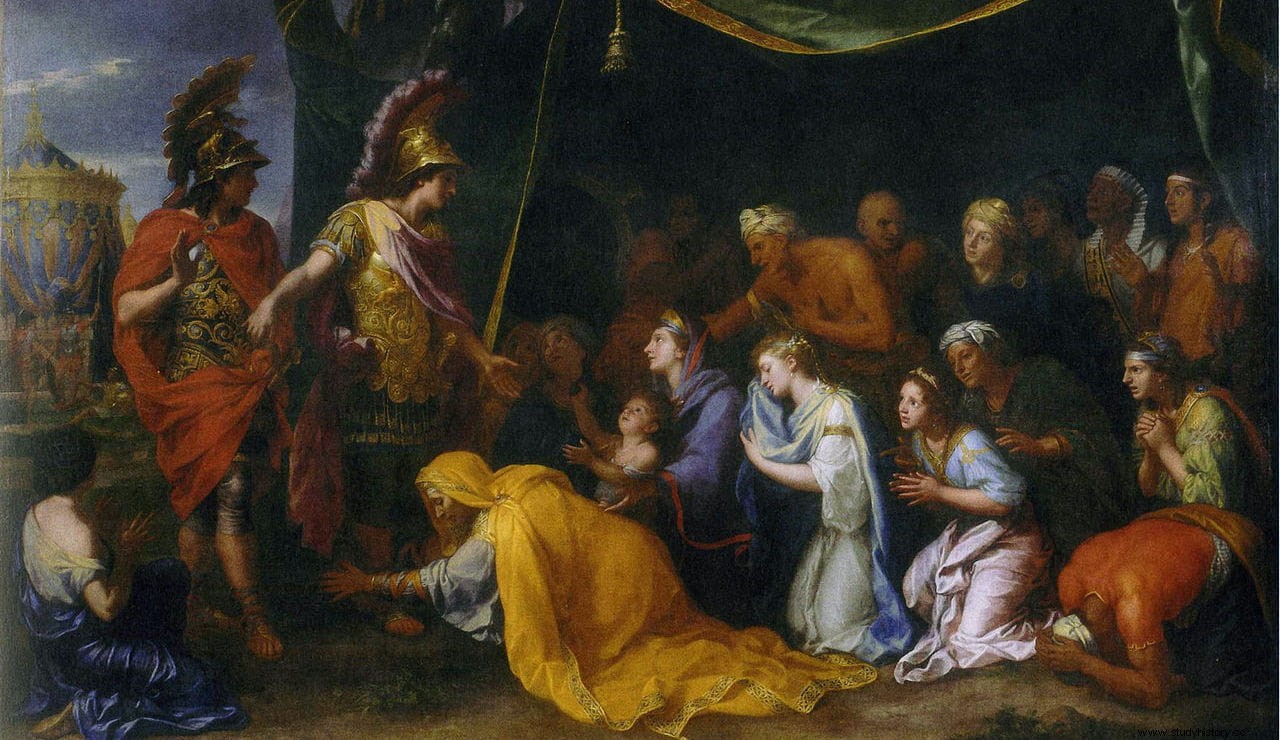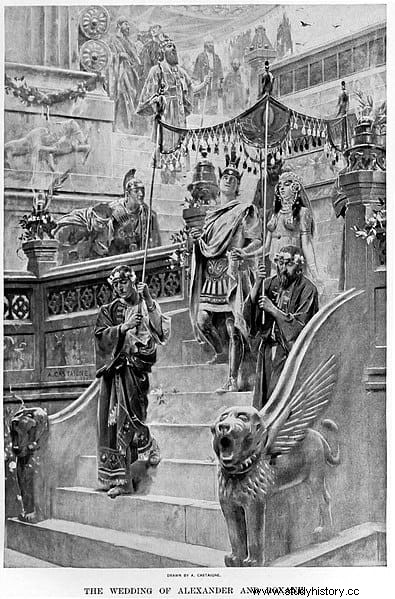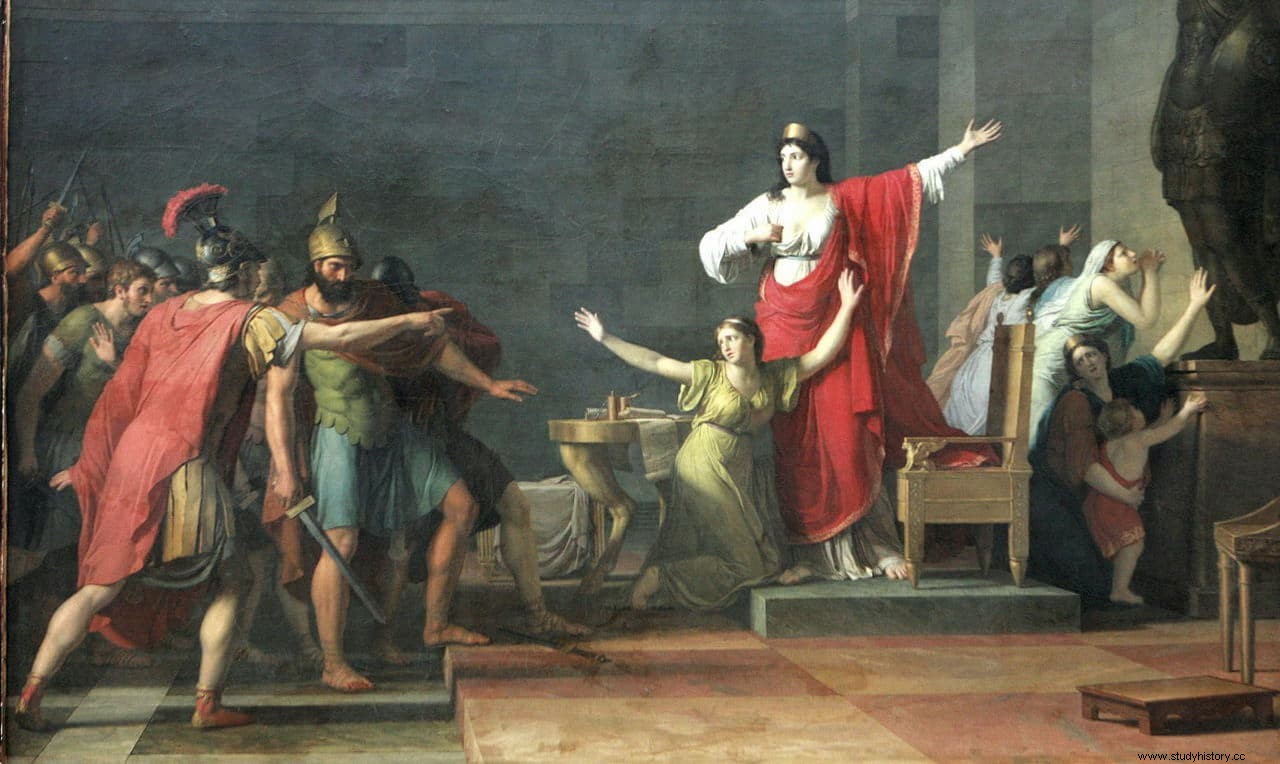The empire forged by Alexander the Great disintegrated on his death due to the lack of a successor by his blood and it is not because the Macedonian had not fathered one, since we know of at least five. After all, apart from lovers like Barsine, the Amazon queen Talestris or the Indian sovereign Cleophis, he took three wives:the Bactrian Roxana was the first and the " authentic «, while the Persians Statira and Parisátida, were for political convenience, to legitimately reign over the Achaemenid Empire after the death of Darius III.
Darius III was the last monarch of his dynasty. He died betrayed by three satraps, Bessos, Nabarzanes and Barsaentes, who did so in order to escape the persecution that Alexander subjected them through Hyrcania and Bactria, after the final debacle in the battle of Gaugamela. The Macedonian lamented that unworthy end, which he assured he did not intend and demonstrated by sending the body to Ecbatana to embalm it and transfer it to Persepolis, where it was given to his mother Sisigambis so that she could dedicate a funeral according to his rank.
In that he reproduced the elegant behavior that he had had with her, who had been a prisoner after the battle of Issos. Darius, resoundingly defeated, had to flee from the Macedonian cavalry in his chariot, leaving behind twenty thousand dead and his own family:his brother Oxatres intervened with a small escort to give him time and he was captured; after him they also remained in the hands of Alejandro Sisigambis, his wife Estatira and his children, two girls (one named after her progenitor and the other Dripetis) and a boy (Oco, who was only six years old) .

Alexander treated them so well that he earned their admiration, to the point that two years later, at Gaugamela, they declined to escape with the Persian detachment that made its way to the Macedonian camp to rescue them; even Oxatres agreed to join the Heitaroi (the elite cavalry that acted as the personal guard of the Great) and Sisigambis refused to cry before the body of her son for having abandoned his own, proclaiming that he only had one offspring who was king of Persia in reference to the captor of him Instead, it is said that upon learning of his death she turned her face to a wall, fasting until she caused his own death.
Estatira was also grateful for the splendid attention received and both she and her mother-in-law forgave Alexander's diplomatic error, who gave them a loom so that they would be entertained without realizing that in Persia this activity was only practiced by slaves. It was even rumored that the baby she was expecting, which caused her death during childbirth in 332 B.C. It was not her husband's but Alexander's. However, legend upon legend, it was also said that the true cause of her death was the sorrow that no descendant of hers would reign. If this had been true, he was mistaken, in a certain way, because his daughters, Statira and Dripetis, had been sent to Susa to receive a Greek education and when they returned an unprecedented double wedding was agreed:Alexander would marry the first and Hephaestion -his right hand- with the second.

In reality, the Macedonian leader had married Roxana in 327 BC. and he considered her her true love. She was the daughter of Oxyartes, a Bactrian nobleman who had followed Besos, so he left his family in the Sogdian Rock, a presumably impregnable fortress... except for the invincible Magnus, who not only conquered it but fell in love with the daughter of his enemy and married her; thus, incidentally, she won the submission of her father. That link was good for Alexander to ensure his position in the region in the face of the conquest of India and the possibility of having offspring (she accompanied him on that campaign and, apparently, suffered a miscarriage). However, there was a but in that second question.
And it is that, although he had her for the legitimate one, he was aware that Roxana was only a minor princess and it was convenient to be linked with someone of royal blood, hence he decided to marry the aforementioned Estatira and even take a third wife, her cousin Parisatid. The latter, daughter of Artaxerxes III and sister of Arses (Artaxerxes IV, who had been succeeded by his cousin Darius III), had been captured by the Macedonian general Parmenio in Issos, thus strengthening the link with the Achaemenid dynasty and, along with Estatira, the Persian tradition of marrying the daughter or widow of the overthrown ruler was fulfilled. Ironic, considering that before Gaugamela the King of Kings had proposed to his enemy the hand of one of his daughters and the other replied that everything he could offer her was already his.
Statira, who is usually accompanied by the ordinal II to differentiate her from her mother (who was not only Darius's wife but also, probably, her sister), was born at an uncertain date in the middle of the fourth century BC. Her parents were said to be of great beauty, so it is likely that she inherited it from her. But the truth is that she is hardly mentioned in the historiographical sources about her husband and some of her, in the case of the Anabasis of Alexander the Great (by Flavio Arriano), they even change her name to call her Barsine, perhaps because that was her official name or perhaps to avoid confusing her with her mother, although in the second case they caused confusion with another character:that was the name of the daughter of Artabazos (satrap of the Hellespont, also a captive of the Macedonians) who was Alexander's hostage since the battle of the Granicus and would become his lover, giving him an illegitimate firstborn named Heracles.
The fact is that the wedding took place in Susa in 324 BC; that is to say, ten years had passed since Issos and Alexander had returned from India with Roxana, who did not have the category of main wife due to her lack of royal lineage and, in fact, shortly after the victory they had suggested the idea of marrying him. with Dario's wife, although he rejected her then. The one in Susa was a massive ceremony, because that day not only he and Hephaestion were married, but also a hundred Macedonian commanders and officers, most belonging to the Heitaroi , for whom as many Persian princesses were chosen with the aim of merging the two cultures and guaranteeing the loyalty of the country. Seleucus, for example, did it with Apama (daughter of Spitamenes, a Sogdian warlord) and Ptolemy with Artakama (daughter of Artabazus, the aforementioned satrap of the Hellespont).
The event lasted five days and was carried out according to the Persian rite, placing a chair next to each groom in order of importance, in which the brides sat down so that their future husbands would take them by the hand and kiss them before take them to their new home. This one was well supplied because Alejandro gave a generous dowry to each couple; later it was learned that thousands of Macedonian soldiers had also taken wives with Persian women and that royal dowry was extended to all. It was, however, an imposture; the Greeks hated the Persians and as soon as the leader died all the Heitaroi They got divorced.

That was about a year later, in June 323 BC. Alejandro was in Babylon absorbed by government tasks and for that reason he hardly paid attention to Estatira, not to mention the fact that his true love was Roxana. He then fell seriously ill, possibly from malaria (he had contracted it in 336 B.C.) or perhaps from Nile fever, although poisoning was also suspected, and he died within eleven days. He was the only glue of the empire that he had forged and, in his absence, it disintegrated; the diádocos, that is to say, his generals, shared the domains but would end up going to a long civil war.
It was worse for Estatira. Her marriage was based on the legitimacy that she provided as the daughter of Darío III, but now she constituted a danger for the son that Roxana was expecting, because Estatira herself was pregnant -or so she said- and her offspring would be of higher rank. Plutarch tells that Roxana conspired with Perdiccas (one of the ten somatophylakes or trusted men of Alexander, who was appointed regent) and invited his rival to a banquet at his house during which he murdered her along with her sister Dripetis (according to some historians, who died with her was not Dripetis but probably Parisatide , which also posed a risk as she was Alejandro's third wife and could provide offspring).
In any case, Roxana herself would become a reflection of that crime some time later. As long as Olympias lived, the Macedonian's mother was under her protection; but Olympias was assassinated in 316 BC. and Cassander, scion of the general Antipater (the regent of Greece while the heir was a minor), saw the opportunity to seize the throne:first, he locked up Roxana and her son, Alexander IV, in Amphipolis (who was entering adolescence because he had born shortly after his father died), and six years later he ordered the poisoning of both. Since he had also bribed Polyperchon (the regent diadochus of Macedon) to assassinate Barsine and Heracles, in this tragic way all the wives and children of Alexander the Great disappeared.
